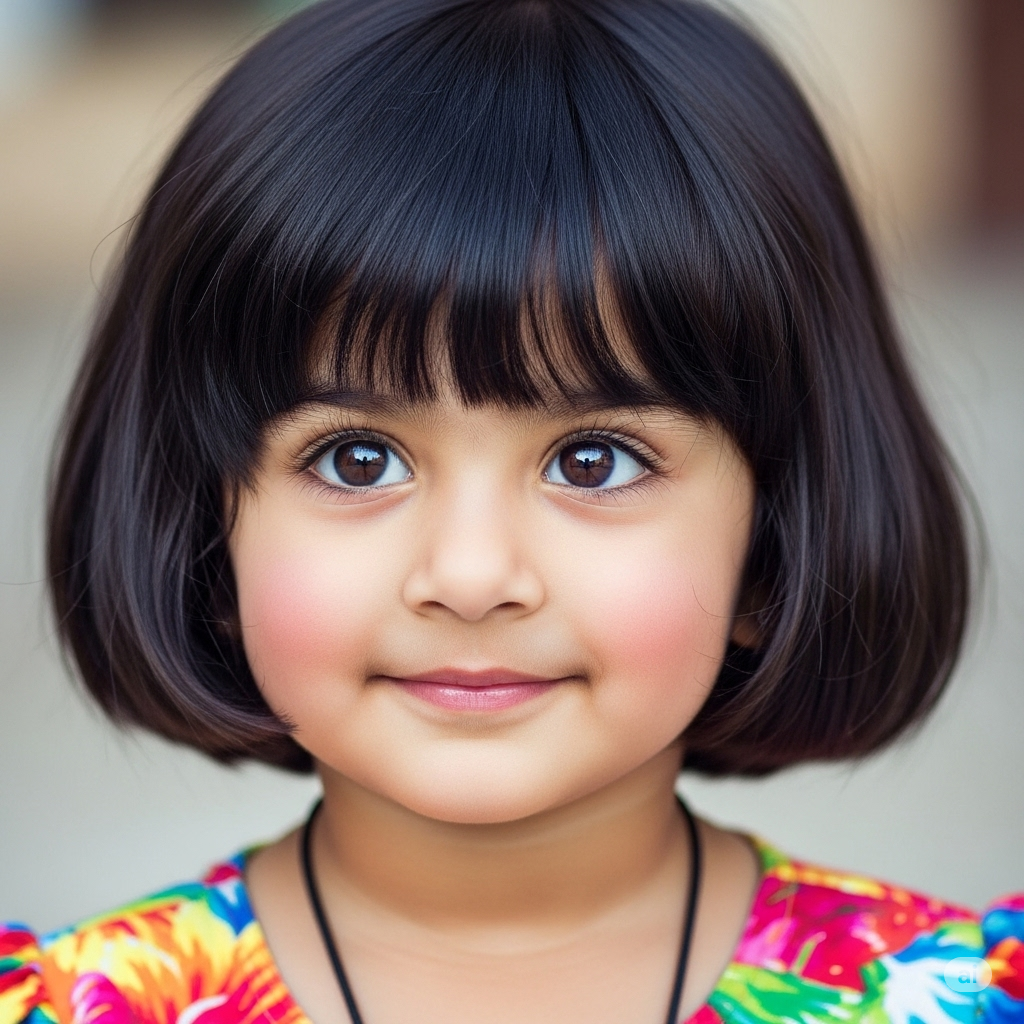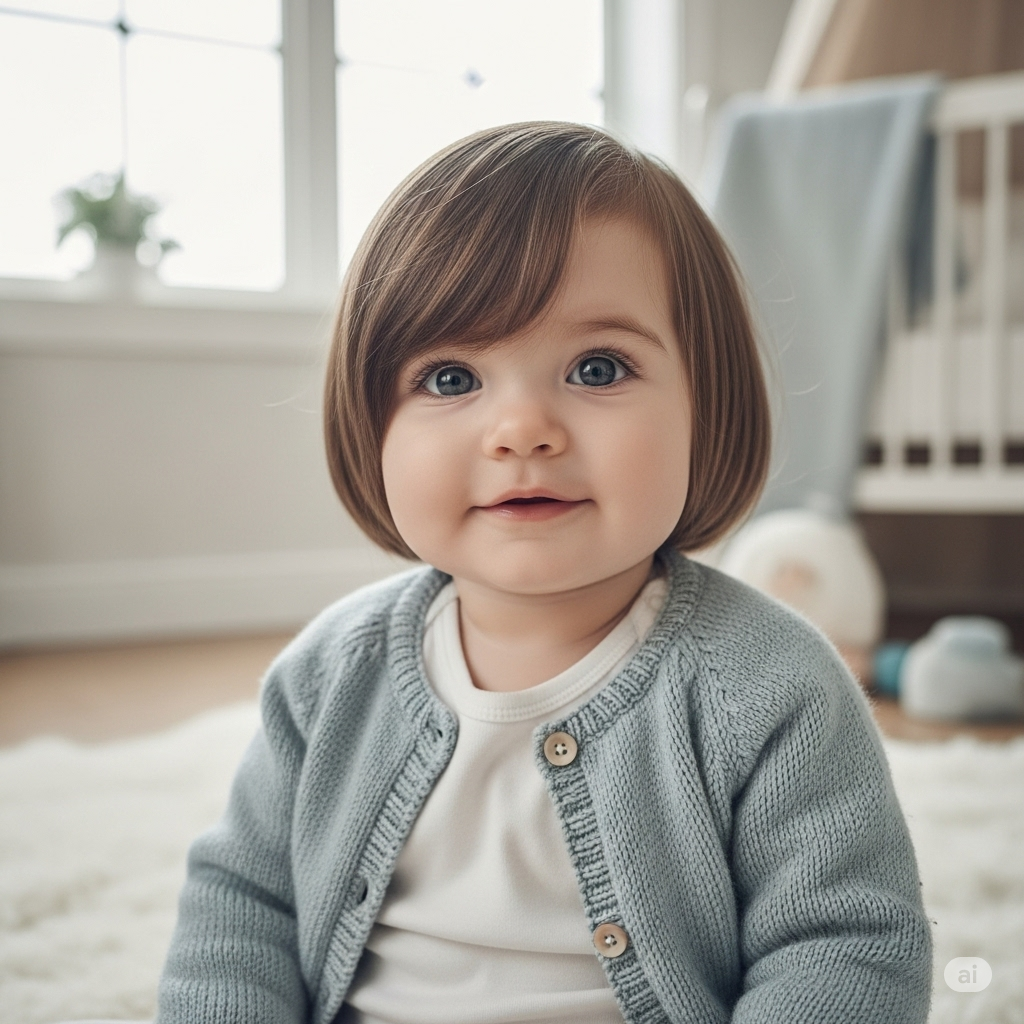Popular haircuts for 3-year-old baby girls continue to prioritize ease of maintenance, comfort, and, of course, an undeniably cute aesthetic. The trends lean towards styles that are practical for active toddlers while still looking adorable. Here are Cute Haircuts for Little Girls in 2025, with details on why they’re chosen and what they look like:
1. Curly Fringe (Bangs for Curls)

A curly fringe, often called bangs for curls, is a Cute Haircuts for Little Girls and charming and popular haircut for children with naturally curly hair. Instead of trying to straighten or smooth the front sections, this style involves cutting the hair at the forehead shorter, allowing the curls to fall naturally across the face.
Description:
For a curly fringe, a stylist carefully identifies the sections of hair that will form the bangs. These sections are then cut to a length that allows them to frame the face, typically falling anywhere from just above the eyebrows to slightly below. The key is to cut these sections while the hair is curly or with the understanding of how the curls will spring up, ensuring the correct length and shape are achieved. The result is a soft, often playful, cascade of curls around the forehead and temples, rather than a straight, blunt line.
Why It’s Popular:
The curly fringe has gained significant popularity for several compelling reasons:
Embraces Natural Texture: One of the primary reasons for its appeal is that it celebrates and highlights a child’s natural curly hair. Instead of fighting against the curls, this style works with them, showcasing their unique bounce and volume. This can be especially empowering for children to see their natural hair texture embraced and looking beautiful.
Adds a Playful and Adorable Frame to the Face: The soft, bouncy curls around the face create an incredibly sweet and youthful look. They can highlight a child’s eyes and cheekbones, adding a touch of innocence and charm. The fringe adds a dynamic element to the overall hairstyle, making it look more styled and intentional without being overly rigid.
Low Maintenance (for curls): While all bangs require some trimming, curly bangs can often be less demanding in daily styling than straight bangs, which might need to be blown dry or straightened regularly. For curly hair, a bit of product to define the curls and a quick finger-comb might be all that’s needed.
Versatility: A curly fringe can be adapted to various curl types, from loose waves to tighter coils. It also pairs well with many other haircuts, whether the rest of the hair is kept long, in a bob, or even a shorter style.
Trend-Forward: Curly fringes have seen a resurgence in popularity in recent years, making them a fashionable choice for children’s hairstyles. Parents often appreciate their child having a modern yet classic look.
In essence, the curly fringe is a delightful choice for children with curly hair, offering a stylish and low-fuss way to enhance their natural beauty.
Best 5 Trending Haircuts for Girls in 2025 – Cutest Styles for Kids
2. Bob with Blunt Bangs (Fringe)

A curly fringe, often known as bangs for curls, is a Cute Haircuts for Little Girls charming and increasingly popular haircut for kids with natural curls. Instead of fighting their natural texture, this style celebrates it by cutting the front sections of hair shorter, allowing the curls to fall beautifully across the forehead.
Description:
To create a curly fringe, a skilled stylist carefully selects the sections of hair that will frame the face. These sections are then cut to a length that lets the curls naturally sit around the forehead and temples. The key is to cut the hair while it’s curly or with a deep understanding of how the curls will spring up once dry. This ensures the fringe has the perfect length and shape. The result is a soft, often bouncy, cascade of curls that beautifully frames the child’s features, creating a whimsical and effortless look rather than a harsh, straight line.
Why It’s Popular:
The curly fringe is a hit for several great reasons:
Embraces Natural Texture: This is a big one! The curly fringe celebrates and highlights a child’s natural curls, showcasing their unique bounce and volume. It’s about working with the hair, not against it, which can be really empowering for kids to see their natural hair looking so beautiful.
Adds a Playful and Adorable Frame to the Face: Those soft, bouncy curls around the face create an incredibly sweet and youthful appearance. They can draw attention to a child’s eyes and cheekbones, adding a touch of innocence and charm. The fringe adds a dynamic element to the overall hairstyle, making it look styled and intentional without being overly rigid or fussy.
Surprisingly Low Maintenance for Curls: Cute Haircuts for Little Girls While all bangs need regular trims, curly bangs can often be less demanding for daily styling compared to straight bangs, which might need constant blow-drying or straightening. For curly hair, a little bit of curl-defining product and a quick finger-comb might be all that’s needed to get them looking great.
Versatility: A curly fringe works well with various curl types, from loose waves to tighter coils. It also pairs beautifully with many other hairstyles, whether the rest of the hair is kept long, in a bob, or even a shorter cut.
Trend-Forward: Curly fringes have definitely made a comeback in recent years, making them a super fashionable choice for kids’ hairstyles. Parents often appreciate their child sporting a look that’s both modern and timeless.
Ultimately, the curly fringe is a fantastic choice for children with curly hair, offering a stylish, low-fuss way to enhance their natural beauty and playful spirit.
Cute Haircuts for Little Girls in 2025 Every Parent Should See
3. Shaggy Layers on Longer Hair

The “shaggy layers” Cute Haircuts for Little Girls in 2025 for children with longer hair is a deliberately styled look that moves away from perfectly uniform layers or blunt cuts. It embraces a more relaxed, effortlessly cool aesthetic.
Description:
Unlike traditional layers that might be smoothly blended, shaggy layers are more pronounced and choppier. This means the layers are cut at varying lengths throughout the hair, often with a slightly less precise, more textured approach. The goal isn’t to create seamless, flowing tiers but rather to produce distinct, piecey sections that give the hair a deliberately messy and cool vibe.
Typically, the layers will be shorter around the crown and top of the head, gradually getting longer towards the ends. This variation in length adds significant volume and movement, preventing longer hair from looking flat or heavy. The choppiness creates visible texture, enhancing the “shaggy” appearance, making it look as though the hair naturally falls into these cool, dishevelled sections. Often, this style is paired with some face-framing pieces or even a soft fringe (bangs) to complete the undone look.
Why It’s Popular:
The popularity of shaggy layers on longer hair stems from its ability to offer a unique blend of style and practicality it is Cute Haircuts for Little Girls:
For Parents Looking for a More Fashion-Forward Look: In an age where individuality and unique style are celebrated, parents are increasingly moving away from overly polished or “perfect” children’s hairstyles. Shaggy layers offer a distinct, modern edge. It’s a look seen on fashion runways and in popular culture, making it appealing for parents who want their child to have a contemporary and stylish appearance. It signals a move beyond traditional, often stiffer, kids’ haircuts.
Less “Perfect” Look That Still Looks Great: This is perhaps the core appeal. The beauty of shaggy layers lies in its inherent “undone” quality. It’s designed to look good even when slightly dishevelled, which is perfect for active children. There’s less pressure for the hair to be perfectly combed or styled at all times. This “less perfect” approach actually makes the hair look more natural and effortlessly chic. It appears as though the child just woke up with great hair, or it naturally fell into place after a day of play. This relaxed aesthetic is highly sought after because it combines ease of maintenance with undeniable style.
Adds Volume and Movement: Longer hair can sometimes appear flat, especially if it’s fine. Shaggy layers inject significant volume and dynamic movement into the hair, giving it life and bounce. The varied lengths prevent the hair from weighing itself down.
Easy to Maintain and Style: Because the style is inherently “messy,” it requires less precise styling. A quick brush or finger-comb, perhaps with a touch of light product for texture, is often all that’s needed. This is a huge advantage for busy parents and active children.
Versatile: Shaggy layers can be adapted to various hair textures, from straight to wavy, enhancing the natural characteristics of the hair. It also grows out gracefully, often maintaining its shape for longer
periods between trims.
4.Long Layers on Medium Hair

Long layers on medium hair is a Cute Haircuts for Little Girls in 2025 classic and highly versatile haircut that adds dimension and vitality to hair that typically falls anywhere from just above the shoulders to the mid-back. This style is designed to enhance the hair’s natural flow and prevent it from appearing flat or overly dense.
Description:
For hair that falls between the shoulders and the mid-back, long, subtle layers are cut throughout. Unlike shaggy layers which are more pronounced and choppy, these layers are designed to be soft and blended. The shortest layers usually start around the collarbone or just below, gradually increasing in length as they descend towards the ends of the hair.
The key characteristic is their subtlety; they are not drastically different in length, but rather strategically placed to remove bulk and create a lighter, more dynamic silhouette. The layering technique typically involves cutting the hair at an angle, allowing the different sections to fall gracefully into one another. This creates a natural, flowing movement that prevents the hair from looking like a single, solid “block” of hair. The overall effect is hair that has more body, bounce, and an effortless, natural sway.
Why It’s Popular:
Long layers on medium hair remain a perennial favorite for several compelling reasons, particularly for children:
Adds Texture and Volume: Medium-length hair, especially if fine or straight, can sometimes appear limp or flat. Long layers are incredibly effective at combating this. By varying the lengths within the hair, the layers create internal movement and lift, instantly adding noticeable texture and volume. This gives the hair a fuller, more lively appearance without sacrificing length.
Makes Hair Easier to Brush: Cute Haircuts for Little Girls in 2025 and One of the most significant practical benefits for both children and parents is how much easier layered hair is to manage. Unlayered medium-length hair, particularly if thick, can become a dense, tangled mass, making brushing a painful chore. The layers reduce the overall bulk and distribute the hair more evenly, significantly minimizing tangles and snags. This makes daily brushing a far more comfortable and quicker experience.
Allows for More Styling Options (Ponytails, Braids, etc.): While a blunt cut can limit styling, long layers actually enhance versatility.
Ponytails: When pulled into a ponytail, the layers create a softer, fuller look instead of a solid, stiff tail. Shorter layers around the face can also gently frame the face even when the rest of the hair is tied up.
- Braids: Layers add visual interest to braids, preventing them from looking too flat or thin. When braided, the subtle variations in length can create a beautiful texture within the braid itself. Even if some shorter layers escape the braid, they often add to a charming, undone aesthetic.
- Half-Up Styles: Layers make half-up styles (like a half-ponytail or twisted sections pinned back) look more dynamic and voluminous.
- Wearing Down: When worn down, the layers give the hair beautiful movement and bounce, preventing it from just hanging lifelessly.
- Grows Out Gracefully: Long layers tend to maintain their shape well as the hair grows, meaning fewer urgent trips to the salon for trims. This is a practical benefit for busy families.
- Universally Flattering: This style works well with almost all hair types (straight, wavy, loosely curly) and face shapes, making it a safe and consistently appealing choice for a wide range of children.
5. Bob with Side-Swept Bangs

The bob with side-swept bangs is a Discover the Cute Haircuts for Little Girls in 2025 perennially chic and versatile Discover the From curly fringes to classic bobs with side-swept bangs hairstyle for children, combining the timeless appeal of a bob haircut with the soft, face-framing elegance of bangs that are swept to one side.
Description:
At its core, this style starts with a bob haircut, which can vary in length from a chin-length cut to one that skims the shoulders. The distinguishing feature, however, lies in the bangs (fringe). Instead of being cut straight across the forehead in a blunt line, these bangs are longer and specifically designed to be swept to one side.
The length of side-swept bangs is crucial; they typically start shorter near the part (or the side they are swept from) and gradually get longer, seamlessly blending into the rest of the hair around the temples and cheekbones. This graduated length allows them to fall naturally to one side without looking disconnected from the main body of the bob. The styling creates a soft, flowing line across the forehead and into the side of the face, rather than a sharp, horizontal cut.
Why It’s Popular:
The bob with side-swept bangs is a highly favored choice for children for several compelling reasons:
Softer Than Blunt Bangs: One of the primary appeals is the gentle aesthetic it offers. Blunt bangs can sometimes appear very strong, bold, or even too severe on a child’s delicate features. Side-swept bangs, by contrast, create a much softer and more graceful frame around the face. They tend to soften facial angles and add a touch of sweetness and innocence, which parents often prefer for younger children.
Less Maintenance as They Grow Out: This is a significant practical advantage for busy parents. Blunt bangs require frequent trims to maintain their precise line and keep them out of the child’s eyes. Side-swept bangs, due to their graduated length and natural flow, tend to grow out much more gracefully. As they get longer, they simply blend further into the rest of the hair, often becoming longer face-framing layers rather than an awkward, overgrown fringe. This means fewer trips to the salon for bang trims, making it a lower-upkeep option.
Cute Haircuts for Little Girls in 2025
Popular Choice for Framing the Face: Side-swept bangs are incredibly effective at framing a child’s face in a flattering way. They draw attention to the eyes and cheekbones, enhancing the child’s natural features without covering too much of the forehead. The diagonal line created by the sweep can also be very flattering for various face shapes, adding an appealing asymmetry that can soften rounder faces or add width to narrower ones. The way they subtly hug the contours of the face adds a polished yet effortless touch to the overall haircut.
Versatility in Styling: While the core look is the side sweep, these bangs still offer some styling flexibility. They can be tucked behind the ear, clipped back with a cute barrette, or allowed to fall freely. This adaptability makes the hairstyle practical for everyday wear and special occasions.
Classic and Timeless Appeal: Both the bob and side-swept bangs are classic elements in hairstyling that never truly go out of fashion. Combining them creates a sophisticated yet age-appropriate look for children that remains stylish year after year.
Explore popular japanese beauty products :- https://allnewupdates.in/japanese-beauty-products/
